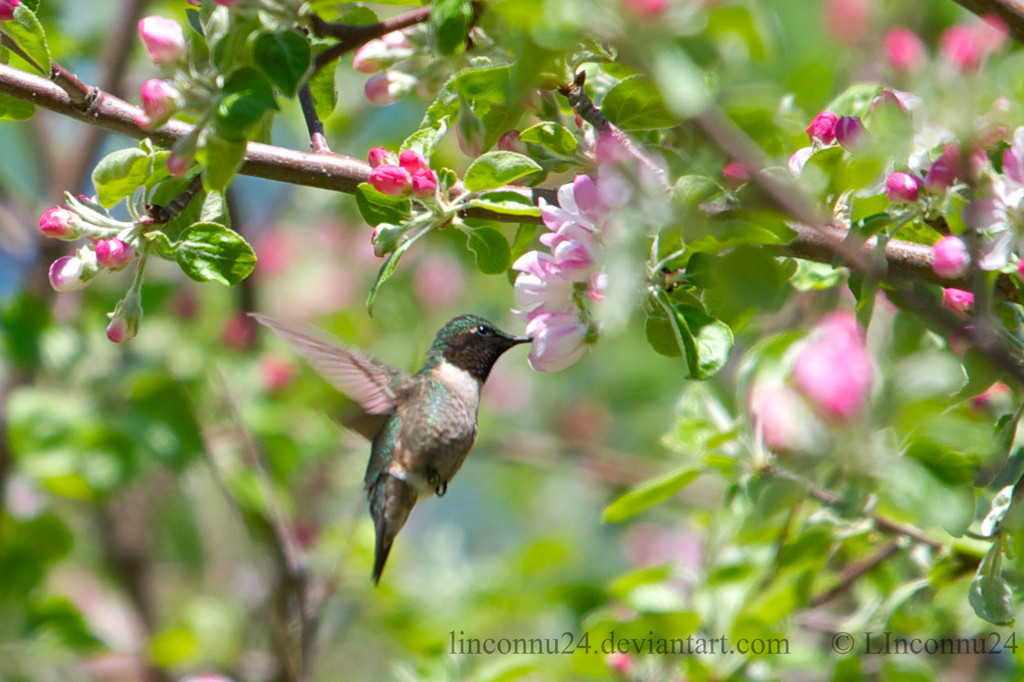HOME | DD
 LInconnu24 — Ruby-throated Hummingbird
LInconnu24 — Ruby-throated Hummingbird

Published: 2012-08-12 23:43:24 +0000 UTC; Views: 498; Favourites: 14; Downloads: 0
Redirect to original
Description
My first Ruby-throated Hummingbird in the Wildlife Reserve of Laurentides




It's crazy how fast this bird is, and it is so small, just few inches! I know how we call it the "oiseau mouche" in french. I have some other shots but they are not best shots that you've seen, cause it was a wild bird in a wild habitat, not a bird in the garden, so it was very difficult to approach it.
Cool Facts:
-The Ruby-throated Hummingbird beats its wings about 53 times a second.
-The extremely short legs of the Ruby-throated Hummingbird prevent it from walking or hopping. The best it can do is shuffle along a perch. Nevertheless, it scratches its head and neck by raising its foot up and over its wing.
-Scientists place hummingbirds and swifts in the same taxonomic order, the Apodiformes. The name means “without feet,” which is certainly how these birds look most of the time.
-The Ruby-throated Hummingbird does not show a strong preference for any particular color of feeder. Instead, it prefers specific feeder locations.
-Ruby-throated Hummingbirds prefer to feed on red or orange flowers. Like many birds, they have good color vision and can see into the ultraviolet spectrum, which humans can’t see.
-Ruby-throated Hummingbirds normally place their nest on a branch of a deciduous or coniferous tree; however, these birds are accustomed to human habitation and have been known to nest on loops of chain, wire, and extension cords.
-Ruby-throated Hummingbirds are eastern North America’s only breeding hummingbird. But in terms of area, this species occupies the largest breeding range of any North American hummingbird.
-Male Ruby-throated Hummingbirds don’t stick around long. Pairs are together long enough for courtship and mating – just a matter of days to weeks. Then he’s off on his own, and may begin migration by early August.
-The oldest known Ruby-throated Hummingbird was 9 years 1 month old.
Habitat:
Open Woodland
Ruby-throated Hummingbirds occur in deciduous woodlands of eastern North America as well as across the Canadian prairies. Commonly associated with old fields, forest edges, meadows, orchards, stream borders, and backyards. On their tropical wintering grounds, Ruby-throated Hummingbirds live in dry forests, citrus groves, hedgerows, and scrub.
Food:
Nectar
Ruby-throated Hummingbirds feed on the nectar of red or orange tubular flowers such as trumpet creeper, cardinal flower, honeysuckle, jewelweed, bee-balm, red buckeye and red morning glory, as well as at hummingbird feeders and, sometimes, tree sap. Hummingbirds also catch insects in midair or pull them out of spider webs. Main insect prey includes mosquitoes, gnats, fruit flies, and small bees; also eats spiders. Ruby-throated Hummingbirds sometimes take insects attracted to sap wells or picks small caterpillars and aphids from leaves.
Nesting Facts:
Clutch Size
1–3 eggs
Number of Broods
1-2 broods
Egg Length
0.5–0.6 in
1.2–1.4 cm
Egg Width
0.3–0.4 in
0.8–0.9 cm
Incubation Period
12–14 days
Nestling Period
18–22 days
Egg Description
Tiny, white, weighting about half a gram, or less than one-fiftieth of an ounce.
Condition at Hatching
Naked apart from two tracts of gray down along the back, eyes closed, clumsy.
Nest Description: The nest is the size of large thimble, built directly on top of the branch rather than in a fork. It’s made of thistle or dandelion down held together with strands of spider silk and sometimes pine resin. The female stamps on the base of the nest to stiffen it, but the walls remain pliable. She shapes the rim of the nest by pressing and smoothing it between her neck and chest. The exterior of the nest is decorated (probably camouflaged) with bits of lichen and moss. The nest takes 6-10 days to finish and measures about 2 inches across and 1 inch deep.
Nest Placement: Females build their nests on a slender, often descending branch, usually of deciduous trees like oak, hornbeam, birch, poplar, or hackberry; sometimes pine. Nests are usually 10-40 feet above the ground. Nests have also been found on loops of chain, wire, and extension cords.
Behavior:
Hovering
Like all hummingbirds, ruby-throats are precision flyers with the ability to fly full out and stop in an instant, hang motionless in midair, and adjust their position up, down, sideways, and backwards with minute control. They dart between nectar sources with fast, straight flights or sit on a small twig keeping a lookout, bill waving back and forth as the bird looks around. Male Ruby-throated Hummingbirds aggressively defend flowers and feeders, leading to spectacular chases and dogfights, and occasional jabs with the beak. They typically yield to larger hummingbird species (in Mexico) and to the notoriously aggressive Rufous Hummingbird. Males give a courtship display to females that enter their territory, making a looping, U-shaped dive starting from as high as 50 feet above the female. If the female perches, the male shifts to making fast side-to-side flights while facing her.
Conservation:
Populations are stable. Hummingbird feeders are generally safe for hummingbirds, but they can create a problem if they make the birds easy targets for cats or if the feeders are placed around nearby windows that the birds might fly into.
-----
Other shots:
Related content
Comments: 2

Wow, awesome shot!
I've tried getting a picture of these little ones, but they are so fast, and I miss everytime, or the photo is blurred. xD
Love the bright colors and the light too. ^^
👍: 0 ⏩: 1

Thank you very much but it's not a awesome photo, I know some people who makes better shots, even of wild little birds like that
Anyway, thank you very much *hug*
👍: 0 ⏩: 0


























